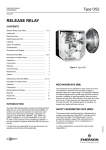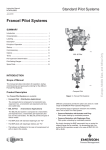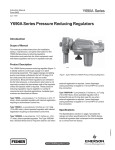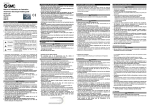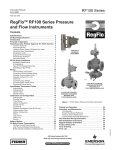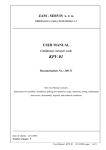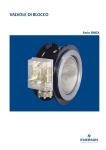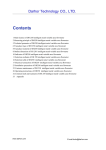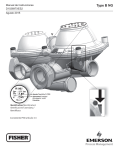Download Emerson EZH and EZHSO Series Pressure Reducing Regulators Instruction Manual
Transcript
OS2 NACE Instruction Manual NTAOS2NACE0603 March 2006 RELEASE RELAY Release Relay (OS2) ............................................................ 1 to 3 Introduction ............................................................................... 1 Mechanism Box ....................................................................... 2 Safety Manometric Box ........................................................... 2 Types of installation .................................................................. 2 Characteristics .......................................................................... 3 Dimensions and weights ......................................................... 3 Mechanism Box (BM) .......................................................... 3 to 6 Description and spare parts ................................................... 3 Operation .................................................................................. 4 Connections ............................................................................. 4 Materials ................................................................................... 5 Commissioning ......................................................................... 5 Maintenance ............................................................................. 6 Options ...................................................................................... 6 Safety Manometric Box (BMS) ........................................ 7 to 12 Description and spare parts ................................................... 7 Operation .................................................................................. 8 Connections ............................................................................. 8 Spring adjustment range ......................................................... 8 Materials ................................................................................... 10 Adjustment ................................................................................ 11 Maintenance ............................................................................. 12 Type OS2 INTRODUCTION 07/02/2008 The OS2 NACE Release Relay consists of a Mechanism Box (BM) and one or two Safety Manometric Boxes (BMS). It’s function is to provoke the activation of a slam shut valve which may be stand alone (OSB, OSE), integrated in a regulator (MP, MPS, Pilot DRPN , ASONEX D, C MAX, DRPN, EZR..) or integrated in a K1000/K3000, in the case of under or over pressure in the controlled gas network. It may be mounted on systems of DN 25 to DN 150 and up to PN 100. It is tight shut and submersible. It may be connected to an explosion-proof contact (intrinsically safe). www.emersonprocess.com/regulators 1 Europe, Middle East, and Africa Document Only CONTENTS MECHANISM BOX (BM) SAFETY MANOMETRIC BOX (BMS) The mechanism box is designed to close a slam shut valve. The operation is ensured in two successive stages: a detection stage and a power stage. The separation between the detection stage and the power stage provides maximum precision, indifferent of working pressure, slam shut valve diameter and gas flow. After activation of the slam shut valve due to over or under pressure, the mechanism box must be reset manually. The complete system is available, on request only, sealed with lead and wire. The pressure data is transformed into a displacement by a safety manometric box (BMS 1) mounted on the mechanism box (BM). This displacement is used to activate the detection stage of the mechanism box in the case of overpressure, over or underpressure, or underpressure condition. In certain configurations, a second box may be used (BMS 2). TYPES OF INSTALLATION Mounting on horizontal pipeline only: Top mounted (stand-alone valve) Bottom mounted (integrated valve and regulator) BM 1 BMS 1 BM 1 BMS 1 N01 N03 1 - BM 1: Mechanism Box with 1 safety manometric box (BMS 1) 3 - BM 1: Mechanism Box with 1 safety manometric box (BMS 1) BM 2 BMS 2 BMS 1 BM 2 BMS 1 BMS 2 N02 N04 2 - BM 2: Mechanism Box with 2 safety manometric boxes (BMS 1, BMS 2) 4 - BM 2: Mechanism Box with 2 safety manometric boxes (BMS 1, BMS 2) 2 Europe, Middle East, and Africa Document Only OS2 NACE OS2 NACE CHARACTERISTICS Memorization Resistance to vertical shocks Resistance to pendular shocks Sealing Inlet Max. pressure Impulse Ambient temperature Max. valve travel Diaphragm or bellows Piston (20 shocks) (20 shocks) 72 h under 2 m of water bar bar C mm DIMENSIONS AND WEIGHTS A A Type BM 1 BM 2 162 71 BMS 27 or 17 236 315 for 1 BMS for 2 BMS Diaphragm Diaphragm Piston Bellows Bellows 185 134 120 BM BMS 1 B B BMS 2 For an OS2 with one BMS add the weight of the BMS to that of the BM 1. For an OS2 with two BMS add the weight of the two BMS to that of the BM 2. 166 N05 5 - Sizes DIMENSIONS (mm) WEIGHTS (kg) A B 2.5 2.5 181 83 2.6 175 36 1.2 204 36 2.3 202 36 2.4 223 36 2.8 1 7 DESCRIPTION AND SPARE PARTS (BM) 9 6 C B A 3 2 5 8 Mechanism box assembly Item Description Mechanism box 1 Cap assembly (indicator, O-ring, screw) 2 Mechanism box casing Box gasket BMS gasket 3 BMS screw BMS sealing screw o-rings 4 Non-connectable brace vent Vent link for 8x10 tube 5 Yoke Fixed bolt axe (do not dismount) 6 Bolt Truarc o-ring Travel stop 7 Damper 8 Mechanism Mechanism screw 9 Resetting tool BM 1 BM 2 181 067 181 068 181 061 142 924 144 071 142 930* 142 931* 402 018* 461 150* 27A5516X012 406 526 181 042 142 920 181 043 406 128 140 324 127 692 181 041 402 512 242 915 4 6a - Mecanism box for 1 BMS N06 6b - Mecanism box for 2 BMS CONNECTIONS Non connectable Connectable Contact * Sold as a set ref. n° 197 351. Items in bold are spare parts 3 Plastic vent with screen Link for 8/10 tube Box exit 1/4" NPT 1/2" NPT Europe, Middle East, and Africa Document Only AG 2.5 AG 5 No memorization 4J 9.81 J IP 68 100 100 - 30° to + 71° 50 Accuracy OS2 NACE DESCRIPTION AND SPARE PARTS (BM) Packing gland assembly ø 24 ø7 ø 24 N08 N07 6c - Standard packing gland Items in bold are spare parts OPERATION (BM) 6d - VSE packing gland VALVE The detection stage consists of two parts: • the releasing stem (1), • the 1st stage trigger (2). TRAVEL STOP 4 Through the intermediate of the safety manometric box (BMS), the pressure provokes a pin movement (D1 or D2), which provokes the rotation of the releasing stem (1) and frees the 1st stage trigger (2). D1 1 3 The power stage consists of two parts: D2 • the 2nd stage trigger (3), • the cam (4). N09 2 The 2nd stage trigger (3), activated by the 1st stage trigger (2), frees the cam (4), which provokes the valve to close. After release, the resetting is ensured in two stages: (detection stage, then power stage) see "commissioning". 7 - Mechanism CONNECTIONS (BM) Position indicator • Fixation BM / Connector: H M7 or H M8 screws 16 N.m torque The position of the detection stage can be seen through the position indicator glass. • Sealed BM / Connector: Flat O-ring (water resistant) Packing gland (gas resistant) Memorization The releasing stem will only start moving when pressure approaches the pressure set point. In all other cases, it remains fixed. Furthermore the assembly has a very high resistance to shocks. If pressure approaches the set point, the releasing stem turns, but with the slightest shock or vibration it will go back to it’s initial position and pressure returns to normal. The mechanism is said to be non memorizing. • Mechanism contact / Slam shut valve: Control rod • BM connector / atmosphere: Integrated vent nipple with screen (supplied) or compression fitting (supplied) for 8/10 tube (not supplied)* Resistance to shocks • Electrical connection: See page 6 This assembly has a remarkable resistance to shocks (20 vertical shocks of 4 J and 20 pendular shocks of 9.81 J), with pressure close to set point (for example: 186 mbar for a set point of 200 mbar). * The 8/10 tube should be angle-shaped on the top to avoid water from entering. 4 4 Europe, Middle East, and Africa Document Only Assembly Packing gland and stem Packing gland O-ring O-ring Fastening screw H M7 Fastening screw H M8 Flat washer (7) Flat washer (8) Packing gland Valve OSB VSE Standard 181 089 181 090 181 104 181 040 181 040 144 126 400 514 400 505 400 514 400 221 402 028 402 028 402 036 402 036 405 005 405 005 405 006 405 006 84 Description OS2 NACE MECHANISM BOX (BM) MATERIAL Mechanism Box (BM) Mechanism Yoke O-rings Aluminium Aluminium Polycarbonate Steel Stainless steel Steel Stainless HR Brass Brass Steel Stainless steel Bronze Steel EPDM Neoprene Nitrile Packing gland Chromatation Chromatation Body Control rod Truarc ring Bronze Stainless steel Nitrile Chromium plating Phosphatation VALVE Phosphatation TRAVEL STOP Phosphatation Phosphatation N10 CLOSED POSITION COMMISSIONING (BM) Commissioning differs depending on whether the assembly has an internal or external bypass and whether overpressure releasing is required or not. See corresponding technical manuals for further details. Note: The position of the travel stop (item. 7 drawing 6a) depends on the type of assembly and it’s size. Position A, B or C depending on max. travel of slam shut valve: A = 15 mm travel, B = 35 mm travel, C = 50 mm travel. WARNING ! AUTHORIZED PERSONNEL ONLY Risk of injury After rearming, remove the reset key from the stem. Do not put fingers in or near the reset mechanism area. ! • Mechanism box (BM) intervention To access the box the cover must be removed. When unscrewing the nut a circlips is used to remove the O-ring. The cover is held on by one screw which can be unscrewed manually or using a socket screw key (max. recommended couple 2.5 N.m). VALVE • Resetting To reset the slam shut (after the fault has been settled), the 1st mechanism stage must be reset by manually turning the 1st stage trigger. If the slam shut has an internal bypass the cam must be slightly turned using a resetting key to bypass. If the slam shut has an external bypass, a bypass valve will be used. In both cases: Wait for the pressure to be equalized before resetting the 2nd mechanism stage. When resetting the 2nd mechanism stage (opening of the valve) a reset key is used (delate). Never use an extension pipe with the reset key when resetting the 2nd stage (max. normal couple 16 N.m, never go over 32 N.m). VALVE TRAVEL STOP TRAVEL STOP N12 N11 RESET DETECTION STAGE RESET POWER STAGE 8a – Release activation stages 5 Europe, Middle East, and Africa Document Only Box Body Cover Position indicator Self-jamming ring Cover nut Circlips All parts Brackets Bolt Elastic O-ring Torsion spring Traction spring Self-jamming ring Flat Cover Truarc ring OS2 NACE MAINTENANCE (BM) Æ Æ • Control Æ 1st and 2nd stage mechanism releasing Æ Packing gland is tigh shut Æ Yoke greasing Æ Æ • Disassembly Æ Check that assembly is not under pressure Æ Manual release of slam shut (drawing n° 7) Manually press on the releasing stem pin D1 or D2 (drawing 7, item 1) parallel to the BMS axe Unscrew the travel stop (screwdriver) Unscrew the BM fastening screws (flat spanner 11 (screw 7) and 13 (or 14) (screw 8) Disassemble the mechanism box (BM) from the connector by unlocking the yoke • Assembly Æ Proceed in reverse order to disassembly OPTIONS (BM) • Remote alert (on BM 1 or BM 2) Detects 2nd stage releasing (power) Contact Max. intensity Max. tension Protection Tightness Temperature Fastening • Remote control Atmospheric solenoid valve (releasing by min. pressure) for max. releasing pressure of 30 bar. Safety manometric box (BMS) activated with a pneumatic or electro-pneumatic impulse. • Manual control on BM 2 with 1 BMS 1 only Push button (connected at the same place as a BMS 2). Cable AC DC 7.0 A 0.8 A 400 V 250 V EEx-d IIC T6 IP 66 - 29°C + 71°C 2 M3 screws 3 wires (black, brown, blue) H05VVF (3 x 0.75 mm²) D 6.5 mm Versions Versions Installation Sealing Connection IP 68 Explosion IP 68 proof IP 65 Intrinsical safe IP 68 Without Explosion proof 1/2 NPT cap 3 m wire Explosion proof connector box/PE explosion proof Intrinsical safe tight-shut connector Common NF NO Connection Black 3 A Blue 4 B Brown 5 C Wires Screwed wiring Welded wiring È C0 C1 C2 C3 Electrical connections Mechanical connections È WIRING WIRING BK 3m BK WIRING BU BU BK BN BN BU BN NF --> BK/BU NO --> BK/BN N F : Normally closed NO : Normally opened C A 123456 NF --> BK(3)/BU(4) NO --> BK(3)/BN(5) N13 Version C1 connection Explosion proof connection with cable and tight-shut packing gland B N14 Version C2 connection Explosion proof connection with explosion proof connector box 8b - Differents versions of BM OS2 connections 6 NF --> BK(A)/BU(B) NO --> BK(A)/BN(C) N15 Version C3 connection Explosion proof connection with sealed connector for intrinsic safe Europe, Middle East, and Africa Document Only Tools : • Spanner 11 (screw 7) and 13 (or 14) (screw 8) • Screwdriver OS2 NACE SAFETY MANOMETRIC BOX (BMS) DESCRIPTION AND SPARE PARTS Safety manometric box 1 (BMS 1) “hook” kit Safety manometric box 1 (BMS 1) “hook” kit Safety manometric box 2 (BMS 2) “hook” kit Safety manometric box 2 (BMS 2) “hook” kit N16 9 - BMS diaphragm Safety manometric box 1 (BMS 1) “hook” kit N17 10 - BMS piston Diaphragm (Max. and/or Min.) Description Compete box Base Hook kit Compete box Base Hook kit Diaphragm BMS 1 BMS 2 Spare parts Safety manometric box 2 (BMS 2) “hook” kit 162 71 181 071 181 105 181 072 181 106 181 084 181 105 181 085 181 106 181 112 142 549 137 906 Set of O-rings N18 11 - BMS bellows Piston (Max. or Min.) 27 27 NACE* 180 999 181 323 181 107 181 322 181 111 181 070 181 107 197 352 * Execution in conformity with the NACE standard MR0175 - 2001 Bellows (Max. and/or Min.) 17 236 315 180 998 181 108 181 073 181 109 181 074 181 110 181 069 181 108 181 086 181 109 181 112 181 087 181 110 400 115 197 352 400 116 Items in bold are spare parts DESCRIPTION (BMS) IS • Impulse line The impulse line (IS) is connected to the network to be protected (normally downstream of the regulator). N19 • Impulse type Depending on the pressure and precision required, different types of impulse may be used: Diaphragm, Piston or Bellows. 12a - BMS 1 max. only D2 • Springs To cover all pressure ranges, a set of springs of equal length and diameter, but of different wire diameter (2 to 6.5 mm), may be used. IS D1 N20 • Detection Possible configurations. Action by 1 BMS 1 Releasing screw Hook BMS Releasing screw BMS 1 Hook 2 Push button BMS BMS 2 Hook 12b - BMS 1 min. only Max. only Min. only Max. & Min. Active Neutral Active Neutral Active Neutral Neutral Active Active Active D2 IS D1 Neutral Active N21 Active Active 12c - BMS 1 max.-min. 7 Europe, Middle East, and Africa Document Only Safety manometric box (BMS) base Safety manometric box (BMS) base Safety manometric box (BMS) base OS2 NACE OPERATION (BMS) The pressure of the network to be protected pushes the diaphragm, piston or bellows. The force resulting from this opposes the force (adjustable) coming from the set-point spring. When pressure varies, the detection rod moves and provokes releasing by max. or min. pressure. Releasing by max. pressure Normal Increase = Set point BMS 1 BMS 2 Releasing screw Push button Without D1 pin Without D2 pin contact With D1 pin contact contact With D2 pin contact BMS 1 BMS 2 Hook Hook Without D2 pin Without D1 pin contact With D2 pin contact contact With D1 pin contact Pressure Normal Decrease = Set point Rotation of releasing stem and 1st stage trigger Rotation of releasing stem and 1st stage trigger CONNECTIONS (BMS) On the mechanism box : BM sealing : On the manometric box : 2 H M6x16 screws (code 402018) Flat O-ring and tight shut O-rings 1/4" NPT screwed Recommended tube: 8/10 mm The sensing line must be connected downstream of the regulator. SPRING ADJUSTMENT RANGES (BMS) (see definitions page 10) BMS Type Size 162 PMS box (bar) 10 Diaphragm MAX. ONLY 071 20 027 100 017 100 236 35 315 72 Piston Bellows MAX. ONLY P setting (bar) SPRING INTERVALS ∆1 ∆1 Ø wire (mm) Code Max. low pt. possible 2.0 2.5 113 195 113 196 0.010 0.025 0.015 0.040 0.035 0.080 0.004 0.005 3.0 3.5 113 197 113 198 0.045 0.070 0.080 0.070 0.140 0.240 0.010 0.014 4.0 5.0 113 199 113 201 0.115 0.140 0.140 0.300 0.380 0.750 0.018 0.050 5.5 6.5 113 202 114 139 0.250 0.450 0.600 1.2 1.3 2.3 0.080 0.170 4.5 5.5 113 200 113 202 1.0 2.1 2.0 4.0 5.1 11.0 0.350 0.700 6.5 5.5 114 139 113 202 4.0 16.0 8.0 16.0 16.0 22.0 1.6 3.0 6.5 5.5 114 139 113 202 22.0 40.0 22.0 40.0 40.0 55.0 6.5 7.0 6.5 5.5 114 139 113 202 55.0 5.5 55.0 11.0 100.0 22.0 12.0 1.6 6.5 5.0 114 139 113 201 8.3 17.5 16.0 35.0 35.0 72.0 2.5 5.0 8 Recommended range Max. low pt. Max. high pt. (bar) Europe, Middle East, and Africa Document Only Pressure Releasing by min. pressure OS2 NACE SPRING ADJUSTMENT RANGES (BMS) (continued) Type Size 162 PMS box (bar) 10 Diaphragm MIN. ONLY 071 20 027 100 017 100 236 35 315 72 Piston Bellows Size Code Min. low pt. possible 2.0 2.5 113 195 113 196 0.010 0.025 0.015 0.040 0.035 0.080 0.004 0.005 3.0 3.5 113 197 113 198 0.045 0.070 0.080 0.070 0.150 0.240 0.010 0.014 4.0 5.0 113 199 113 201 0.115 0.140 0.150 0.300 0.400 0.650 0.018 0.050 5.5 6.5 113 202 114 139 0.250 0.450 0.600 1.1 1.15 2.0 0.080 0.170 4.5 5.5 113 200 113 202 1.0 2.1 2.0 4.0 4.7 9.5 0.350 0.700 6.5 5.5 114 139 113 202 4.0 16.0 8.0 16.0 14.4 19.0 1.6 3.0 6.5 5.5 114 139 113 202 19.0 38.0 19.0 38.0 38.0 50.0 6.5 7.0 6.5 5.5 114 139 113 202 50.0 5.5 50.0 11.0 90.0 16.0 12.0 1.6 6.5 5.0 114 139 113 201 8.3 17.5 16.0 28.0 28.0 65.0 2.5 5.0 162 MAX. & MIN. 10 Diaphragm 071 Piston Bellows 027 017 20 Recommended Range Min. low pt. Min. high pt. MAX. & MIN. SPRING PMS box (bar) INTERVALS ∆1 Ø wire (mm) BMS Type MIN. ONLY P setting (bar) SPRING ∆1 (bar) INTERVALS ∆1 & ∆2 P setting (bar) Ø wire (mm) Code Min. low pt. possible Max. high pt. ∆1 (bar) ∆2 (bar) 2.0 113 195 0.010 0.035 2.5 3.0 113 196 113 197 0.025 0.045 0.080 0.140 0.004 0.005 0.010 0.025 3.5 4.0 113 198 113 199 0.070 0.115 0.240 0.380 0.010 0.014 0.050 0.060 5.0 5.5 113 201 113 202 0.140 0.230 0.750 1.3 0.018 0.050 0.150 0.350 6.5 4.5 114 139 113 200 0.450 1.0 2.3 5.1 0.080 0.170 0.600 1.1 5.5 6.5 113 202 114 139 2.1 4.0 11.0 16.0 0.350 0.700 2.5 5.5 1.6 10.0 1.6 10.0 2.5 5.0 20.0 33.0 Not possible with only 1 BMS 236 35 5.5 6.5 113 202 114 139 5.5 8.3 22.0 35.0 315 72 5.0 113 201 17.5 72.0 9 Europe, Middle East, and Africa Document Only BMS OS2 NACE PMS box Pa Pa max Pa min Pd max Max. high pt. Max. low pt. Max. low pt. possible Pd min Min. high pt. Min. low pt. Min. low pt. possible ∆1 ∆2 Maximum operational box pressure Nominal downstream regulator pressure Maximum downstream regulator pressure (normally closing regulator pressure) Minimum downstream regulator pressure (disturbance in function with flow and/or inlet pressure is to be considered) Maximum releasing pressure High regulator pressure at maximum Low regulator pressure at maximum remaining within the accuracy class Low regulator pressure at furthest maximum point (precision is not guaranteed) Minimum releasing pressure High minimum regulator pressure Low regulator pressure at minimum remaining within the accuracy class Low regulator pressure at furthest minimum point (precision is not guaranteed) Minimum difference allowed between Pd max. and Pa max. and/or between Pd min. and Pa min. Maximum difference allowed between maximum and minimum releasing pressure SELECTION GUIDE LINES: PRESSURE LIMITATIONS Max. only Pd max. ≤ PMS box (BMS) Pd max. ≤ Max. high pt. Pd max. ≥ Max. low pt. Pd max. ≥ Pa max. + ∆1 Min. only Pa max. < PMS box (BMS) Pd min. ≤ Min. high pt. Pd min. ≥ Min. low pt. Pd min. ≥ Pa min. - ∆1 Max. & Min. Pd max. ≤ PMS box (BMS) Pd max. ≤ Max. high pt. Pd max. ≥ Pa max. + ∆1 Pd min. ≥ Min. lowest pt. possible Pd min. ≤ Pa min. - ∆1 Pd max. - Pd min. ≤ ∆2 Note: When the set point (max. or min.) falls between the lowest and lowest pt. possible, the precision may pass into a superior range (example AG 2.5 —> AG 5). If the pt. value is too close to that of the Pa, the option RJGI tripping is recommended (consult factory). In the case of 2 safety manometric boxes (BMS) both boxes should have a PMS > to the highest Pd max. SELECTION OF BMS AND SPRINGS MATERIALS (BMS) Chose the type of safety manometric box (BMS) according to: PMS, the type of releasing precision PMS 0 - 20 20 - 72 72 - 100 AG 2.5 AG 5 Max. only Min. only Max. & min. (*) Diaphragm Bellows Piston Diaphragm Bellows Piston Piston NACE Spring case Zinc pl steel Stainless steel Spring box Aluminium + Chromatation Diaphragm Nitrile mesh Piston Stainless steel Stainless Bellows steel Spring Zinc pl steel Stainless steel Adjustment Zinc pl steel screw (*) Choice between piston (regular) and bellows (optional). Bellows are recommended if you require a small gap between releasing pressure, inlet pressure and exact precision. Pistons do not allow for minimum and maximum releasing. Choice of springs: • Max. only or min. only Take the spring with the highest point directly superior to the releasing pressure required. • Max. and min. Take the spring with the highest maximum point superior to the maximum releasing pressure required or with the lowest point inferior to the minimum tripping pressure required. 10 10 Europe, Middle East, and Africa Document Only DEFINITIONS OS2 NACE WARNING ! AUTHORIZED PERSONNEL ONLY Risk of injury After rearming, remove the reset key from the stem. Do not put fingers in or near the reset mechanism area. ! • Adjusting the releasing screw Free the min. hook (2). Then in the following conditions: - set-point spring decompressed (adjustment screw (5) unscrewed), - pressure equal to the max. releasing pressure required in the BMS, adjust the releasing screw (1) to X = 0 mm (detection stage set). Release manually. Unscrew the releasing screw (1) 2 turns, which represents a distance of approximately 1.5 mm. Jam nut (3). • Max. adjustment Same procedure as paragraph "Adjusting max. only releasing pressure". • Min. adjustment Admit an average pressure between max. and min., (for example: regulator set-point pressure). Set the slam shut. Admit a pressure equal to the min. Pd min. releasing pressure required. Adjust the hook (2) by progressively moving nuts (6) and (7) until it releases. Jam nuts (6) and (7). Check the pressure value at the releasing point (adjust if necessary). ADJUSTMENT (BMS) Generally speaking, adjustments are carried out with the slam shut valve closed. Only the detection stage is reset. Control of the releasing value may be obtained by resetting the two stages. Warning Before any adjustment, check that the spring range installed corresponds to the required set point BMS 1 (Diagrams 9 to 11 page 7) RELEASING BY MAX. ONLY Y 2 1 3 5 4 • Adjusting the releasing screw Free the min. hook (2). D2 Then in the following conditions: D1 - no pressure in the safety manoX metric box (BMS), 6 7 - set-point spring compressed so N22 X = distance between releasing that the distance between the screw and pin D1 releasing screw and the pin D1 no Y = distance between releasing longer increases, adjust the releasing screw and pin D2 screw (1) to X = 1.5 mm (detection stage set). Jam nut (3). BMS 2 with 1 max. only BMS 1 RELEASING BY MAX. ONLY • Adjusting the max. only releasing pressure Admit the releasing pressure to Pd max. Screw the adjustment screw (5) until detection stage can be set. Unscrew the adjustment screw (5) until detection stage release. Check the pressure value at the releasing point (adjust if necessary). Jam nut (4). • Adjusting the max. push button Remove the hook (2). Then in the following conditions: - no pressure in the BMS, - set-point spring compressed so that the distance between the push button (1) and the pin D2 no longer increases, adjust the push button (1) to X = 1.5 mm (detection stage set). Jam nut (3). RELEASING BY MIN. ONLY • Adjusting the releasing screw and hook Free the min. hook (2). Then in the following conditions: - set-point spring decompressed (adjustment screw (5) unscrewed), - pressure equal to the releasing pressure required for Pd min in the BMS, adjust the releasing screw (1) to X = 2 mm (detection stage set). Jam nut (3). Put the hook (2) into position and adjust Y = 1.5 mm with nuts (6) and (7). Jam nuts (6) and (7). 4 5 3 1 X D2 MAX. ONLY BMS 1 ADJUSTMENT D1 Y 6 2 N23 • Adjusting the max. only releasing pressure Same procedure as paragraph "Adjusting the max. only releasing pressure". • Adjusting the min. only releasing pressure Continue admitting the required releasing pressure. Screw the adjustment screw (5) until detection stage release. Check the pressure value at the releasing point (adjust if necessary). Jam lock nut (4). RELEASING BY MIN. ONLY • Adjusting the min. only hook Remove the max. push button (1) or screw it tight to neutralize it. Jam nut (3). 11 Europe, Middle East, and Africa Document Only RELEASING BY MAX. AND MIN. (diaphragm or bellows only) OS2 NACE ADJUSTMENT (BMS) (continued) MAINTENANCE (BMS) RELEASING BY MIN. ONLY (CONTINUED) Then in the following conditions: - set-point spring decompressed (adjustment screw (5) unscrewed), - pressure equal to releasing pressure required in the BMS, adjust the min. hook (2) to Y = 1.5 mm (detection stage set). Jam nut (6). • Adjusting min. only releasing pressure Same procedure as paragraph "Adjusting max. only releasing pressure". • Disassembly Æ Unscrew the connector form the sensing line Æ Remove the safety manometric box (BMS) Æ Unscrew the blocking nut on the adjustment screw (manually) Æ Unscrew the adjustment screw (resetting tool) Æ Remove the hook or plate, depending on the type of BMS 1 or 2, from the detection rod (flat spanner 7) Æ Remove the upper case BMS 162 (flat spanner 11) BMS 071 (flat spanner 8) BMS piston 27/17 (key 5) BMS bellows 236/315 (key 5) Æ Disassemble the set plate/counter plate (Flat spanner 17 and pliers) or Æ Remove the bellows or piston and guide (manually) RELEASING BY MAX. AND MIN. • Adjusting the push button The min. hook (2) is completely unscrewed. Then in the following conditions: - set-point spring decompressed (adjustment screw (5) unscrewed), - pressure equal to the max. releasing pressure required in the BMS. adjust the push button (1) to X = 0 mm (detection stage set). Release manually. Unscrew the push button (1) 2 turns, which represents a distance of approximately 1.5 mm. Jam nut (3). • Adjusting the releasing pressure to max. and min. Max. adjustment Same procedure as paragraph "Adjusting the max. only releasing pressure". Min. adjustment Admit an average pressure between max. and min., (for example regulator set-point pressure). Set the detection stage. Admit a pressure equal to the min. releasing pressure required. Screw the hook (2) progressively until detection stage release. Jam nut (6). Check the pressure value at the releasing point (adjust if necessary). • Assembly Æ Proceed in reverse order to disassembly • BMS torque values Æ Upper spring case/manometric box BMS 162: BMS 071: BMS piston 27/17: BMS bellows 236/315: Æ Emerson Process Management Natural Gas Technologies Francel S.A. Z.A. La Croix St. Mathieu 28320 Gallardon - France Tel. +33 (0)2 37 33 47 00 Fax. +33 (0)2 37 31 46 56 www.emersonprocess.com/regulators © Francel S.A. 2006, printed in France by MARCOM Francel Characteristics, dimension and diagrams only commit Francel after written confirmation 12 8 N.m 5 N.m 6 N.m 6 N.m BMS 162 and 071 nut/diaphragm plate: 20 N.m Europe, Middle East, and Africa Document Only • Control Æ Slam shut releasing (twice yearly) Æ External tight shut Æ Impulse part (diaphragm, bellows or piston)












